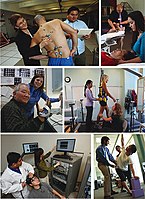
Photo from wikipedia
aaa The papers in this issue of Kinesiology Review collectively constitute the bulk of the Proceedings of the National Academy of Kinesiology (NAK) and are expansions on a series of… Click to show full abstract
aaa The papers in this issue of Kinesiology Review collectively constitute the bulk of the Proceedings of the National Academy of Kinesiology (NAK) and are expansions on a series of presentations given at the 89th annual meeting held in Bellevue, WA, September 12–14, 2019. The theme of the conference was the “Optimization of Human Performance,” and 13 scholars who are internationally recognized leaders in kinesiology and beyond presented their views on this topic from multiple perspectives spanning the historical and philosophical to the biophysical and sports-medicine dimensions. We now present full papers from 10 of those presentations in this issue. The highest levels of human performance are inspiring and captured by the Olympic motto Citius, altius, fortius (Faster, higher, stronger), which characterizes the beauty of the moving body at its limits or capacity. Remarkably, the highest-level performance of an athlete is sometimes associated with an apparent ease of exertion in such exceptional performers as Wilma Rudolph, who won gold as a sprinter in 100-m, 200-m, and 4 × 100-m events at the 1960 Rome Olympics and was affectionately referred to by European press as the Black Gazelle, while Red Grange, the outstanding football halfback nicknamed the Galloping Ghost, who played at the University of Illinois in the 1920s and went on to star with the Chicago Bears, also moved with apparent ease. Grange’s movements during game performance, similar to those ascribed to Rudolph, were also described as beautiful, fluid, and graceful and akin to that of nimble deer in the woods by his college coach Bob Zuppke. As such, human performance can embody both beauty and functionality. In this vein a subtheme of the conference was, in fact, that of efficiency or economy of motion for optimization, and it certainly applies, beyond the speedsters, to the endurance athletes and all who must sustain their efforts on the job, as well as on the field of play, since economy of movement preserves the energy substrates that fuel the human machine. Although these examples capture the movements of superior athletes, the arena of human performance also includes the actions of first responders and soldiers in highly stressful environments and extends to the movements of those who are challenged by age, infirmity, and disease who are doing their best to execute their activities of daily living and achieve the goals that are meaningful to them (e.g., rising from a chair and walking to the washroom in an attempt to maintain independence). A phrase that is often used to describe the content of kinesiology is that of health and human performance, and the health dimension is essentially intertwined with performance in that cognitive-motor skill is the fundamental requisite for engaging in physical activity. Thus, there is need for skill to move and accrue the many health benefits of activity—both physical and mental. It is noteworthy that the U.S. federal government (Health and Human Services) is about to or has just released Healthy People 2030, the Physical Activity Guidelines, and a National Youth Sport Initiative, and it takes both skill and performance to participate while the performances involved with such participation lead to healthpromoting outcomes. The intent of the NAKmeeting was to understand the essential nature and expression of skillful human performance and how it is achieved. The emphasis of the speakers at the meeting leaned toward superior performers, but the principles apply to all. It takes all subdisciplines working in concert to approach such understanding, and that was the approach taken here. As such, the approach was that of including multiple perspectives (historical to biophysical to neural, pedagogical, big data, and sports medicine)—it takes the landscape of kinesiology and all its subdisciplines considered in harmony to capture the phenomenon (see Figure 1). Of course, there is great specificity to the expression of optimal performance, so one formula does not apply across the board, but there are fundamental issues related to pedagogy, learning, physiology, and injury prevention (sports-medicine topics were covered broadly in the scope of the meeting, and the importance lies in keeping the performer, whether an athlete or not, “in the game” since those pushing their limits, whatever they may be, are always flirting with injury and overtraining) that generalize to all, and that is what was covered to the extent that the format and duration of the meeting could accommodate! The following passages overview the content and flow of the optimization of human performance.
Journal Title: Kinesiology Review
Year Published: 2020
Link to full text (if available)
Share on Social Media: Sign Up to like & get
recommendations!